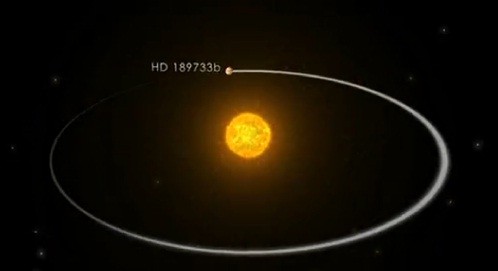Weird Atmospheric Changes Seen in an Exoplanet [STUNNING PHOTOS AND VIDEO ]
Nasa astronomers have witnessed weird atmospheric changes in an closeby exoplanet. An international team of astronomers has detected major changes in the atmosphere of a planet, HD 189733B, which is located beyond our solar system. They discovered the atmospheric changes by analysing the data obtained from Nasa's Hubble Space Telescope.
The HD 189733b is a gas giant similar to Jupiter, but it is 14 percent larger and more massive than Jupiter. The planet is located just 63 light-years away from earth.
The HD 189733B planet orbits its star - HD 189733A- at a distance of only three million miles, or about 30 times closer than earth's distance from the sun and completes an orbit every 2.2 days. The HD 189733A is about 80 percent the size and mass of our sun.
Previously, astronomers had found a huge amount of hydrogen gas was escaping from the planet's upper atmosphere and they also found that the temperature on that planet was continuously varying, but they did not have any clue as to why it was happening.
"Astronomers have been debating the details of atmospheric evaporation for years, and studying HD 189733B is our best opportunity for understanding the process," said Vincent Bourrier, researcher at the Paris Institute of Astrophysics.
Now, the study has revealed that atmospheric variations on the planet occurred in response to a powerful eruption on the planet's host star.
"The multiwavelength coverage by Hubble and Swift has given us an unprecedented view of the interaction between a flare on an active star and the atmosphere of a giant planet," said Alain Lecavelier des Etangs, researcher at the Paris Institute of Astrophysics (IAP), in a statement.
Scientists analysing the data have found that HD 189733B planet receives 10 thousand times more stronger and powerful X rays than what the earth receives from an X class solar flare.
During the solar flare, scientists also found that at least 1,000 tons of gas was leaving the planet's atmosphere every second. The hydrogen atoms were moving at a speed greater than 300,000 mph.
"The planet's close proximity to the star means it was struck by a blast of X-rays tens of thousands of times stronger than the earth suffers even during an X-class solar flare, the strongest category," said co-author Peter Wheatley, a physicist at the University of Warwick in England.
Watch the video:




© Copyright IBTimes 2024. All rights reserved.






